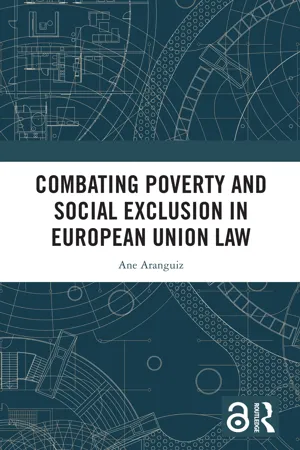
- 276 pages
- English
- ePUB (mobile friendly)
- Available on iOS & Android
Combating Poverty and Social Exclusion in European Union Law
About this book
This book examines the potential role of European Union law in combating poverty and social exclusion in the European Union.
Anti-poverty strategies have been part of the European Union agenda for decades. Most saliently, over a decade ago, the EU's Member States pledged to lift 20 million people out of poverty. In spite of this commitment, the EU did not even meet a quarter of this target, and over 113 million people still were at risk of poverty and social exclusion by the end of 2020. This book addresses the incongruence between a quite developed EU policy strategy and a well-embedded legal objective on the one hand, and the lack of direct legal action on the other. Analysing the role of social policy instruments, fundamental rights, and the constitutional framework of the European Union, it makes a detailed case for a contribution of EU law to the policy objective of combating poverty and social exclusion.
Drawing on work in law, politics, social policy and economics, this book will interest scholars and policymakers in the areas of EU law, labour and social security, human rights, political science and social and public policy.
The Open Access version of this book, available at www.taylorfrancis.com, has been made available under a Creative Commons Attribution (CC-BY) 4.0 license.
Frequently asked questions
- Essential is ideal for learners and professionals who enjoy exploring a wide range of subjects. Access the Essential Library with 800,000+ trusted titles and best-sellers across business, personal growth, and the humanities. Includes unlimited reading time and Standard Read Aloud voice.
- Complete: Perfect for advanced learners and researchers needing full, unrestricted access. Unlock 1.4M+ books across hundreds of subjects, including academic and specialized titles. The Complete Plan also includes advanced features like Premium Read Aloud and Research Assistant.
Please note we cannot support devices running on iOS 13 and Android 7 or earlier. Learn more about using the app.
Information
Chapter 1 Introduction
1.1 Setting and background
Table of contents
- Cover
- Half-Title
- Title
- Copyright
- Contents
- Preface
- Abbreviations
- 1 Introduction
- 2 The EU social policy context
- 3 The EU fundamental social rights landscape
- 4 The EU constitutional framework
- 5 Implementing the objective of combating poverty and social exclusion under EU law
- 6 General conclusions
- Index